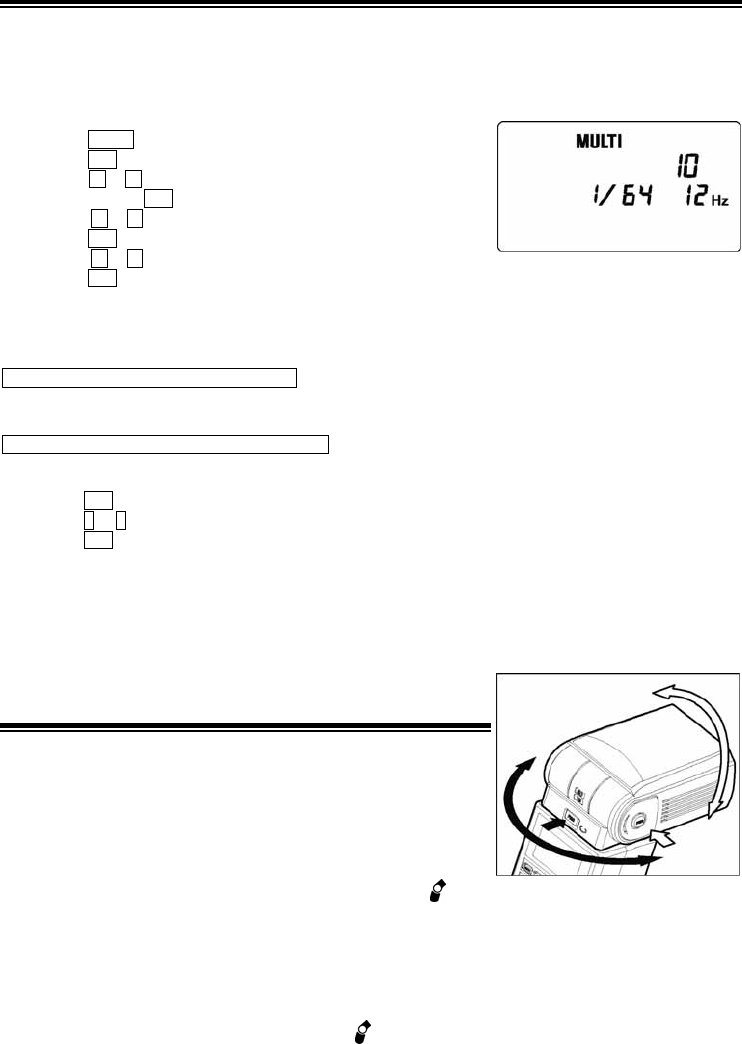
20
MULTI FLASH MODE
When a slow shutter speed is used, the flash will fire repeatedly while the shutter is open. By doing so a
series of images of the subject will be exposed in one frame. A dark background with a bright subject
shows the result more effectively in this mode. It is possible to set the firing frequency between 1Hz and
100Hz. Up to 100 flashes can be fired continuously. The maximum number of flashes varies, depending on
the flash guide number and firing frequency settings. (Please refer to table3 on the last page).
1. Set the camera’s exposure mode to M and set the desired aperture.
2. Press the
MODE button until the multi-flash mode appears.
3. Press the SEL button until the flash firing frequency starts to blink.
4.
Press the
+
or
–
button to set the desired flash frequency value.
5. After pressing the SEL button again, the flash power level will blink.
6. Press the
+
or
–
button to set the desired power level.
7. Press the SEL button again, the number of flashes will blink.
8. Press the
+
or
–
button to set the desired number of flashes.
9. Press the SEL button until the display stops blinking.
10. When the ready light of the flash is illuminated, the unit is ready to use.
Note: Please set the shutter speed longer than; Number of Flashes you want Firing Frequency
How to set the correct flash power level
Page 17 <<CHART
A
>> combination of
1
Read out the subject distance from the focus ring on the lens. Then adjust the aperture ring on the lens
until the distance indicated on the LCD panel of the flash and the subject distance become about equal.
When using with cameras other than the above
Read-out the subject distance from the focus ring on the lens. Either change the flash power level or the
flash’s F-stop. Please refer following on how to change the flash’s F-stop.
1. Press the
SEL button several times to make the F-stop indicator blink.
2. Press the + or – button and set the F-stop.
3. Press the SEL button and make the indicator of F-stop stop blinking.
Please set the distance indicated on the LCD panel of the flash and the actual subject distance so that they
are about equal.
Then set that F-stop on the lens aperture ring.
* You can calculate the correct exposure by using this formula:
Guide Number “GN” / Flash to Subject Distance = F-stop
This flash unit will calculate and indicate the Subject Distance by following the above formula. (Please
refer to table 1 on the last page)
BOUNCE FLASH
When you take a photo with flash in a room, sometimes a strong
shadow will appear behind the subject If you point the flash head
upwards or sideways to reflect the light off the ceiling, wall etc, the
subject will be illuminated softly. Press the lock button and adjust the
flash head to set the bounce angle.
UP: 0°, 60°, 75°, 90° DOWN: 0°,7°
RIGHT: 0°, 60°, 75°, 90
LEFT: 0°, 60°, 75°,90°, 120°, 150°, 180°
When the bounce flash mode is activated, a bounce indicator
will appear on the LCD panel.
Choose a white surface for bouncing the flash, otherwise the image’s colour may be incorrect. Depending
on the reflecting surface, the subject distance and other factors, the effective distance range for the TTL
AUTO may change. Please check for correct exposure confirmation (TTL BL or TTL mark on the LCD
panel) after releasing the shutter.
Close-up Exposures
Bounce flash can be tilted 7° downward for close-ups. The Flash will be effective only for the subjects 0.5
meter to 2 meters. When the flash head is tilted 7°
will blink.













